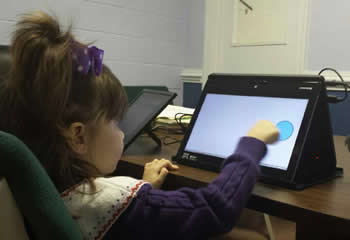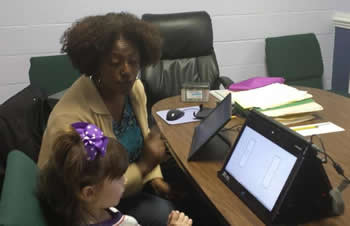Our battery is composed of 7 EF and 2 non-EF (one warm-up/orientation, the other simple reaction time) tasks. The setup involves a Windows based machine (preferably Windows 7 or greater) and a peripheral monitor. The person who administers the task reads instructions, to the child, that appear on one of the monitors and the child’s responses are recording through their touches on the other monitor.
 The battery is intentionally modular, with each EF task taking approximately 3-7 minutes to complete. This permits the person who is administering the tasks to introduce as many/few breaks as are needed by the child. The specific set and order of tasks can also be individualized. The non-EF tasks are typically administered first in order to orient the child about how to respond to questions using the touch screen. In addition, the simple reaction time task provides an estimate of processing speed that can be used as a covariate in subsequent analyses. Each EF task begins with a series of ‘practice’ trials. A child has up to 2 opportunities to pass these trials. After 2 failures, the task is automatically discontinued.
The battery is intentionally modular, with each EF task taking approximately 3-7 minutes to complete. This permits the person who is administering the tasks to introduce as many/few breaks as are needed by the child. The specific set and order of tasks can also be individualized. The non-EF tasks are typically administered first in order to orient the child about how to respond to questions using the touch screen. In addition, the simple reaction time task provides an estimate of processing speed that can be used as a covariate in subsequent analyses. Each EF task begins with a series of ‘practice’ trials. A child has up to 2 opportunities to pass these trials. After 2 failures, the task is automatically discontinued.
Task Descriptions
Spatial Conflict Arrows – This is a Simon task similar to those used in the child development literature (e.g., Davidson et al., 2006) to measure the child's ability to inhibit a dominant response. It is also referred to simply as Arrows. In this task children are asked to follow the rule of “touching the button in whichever direction the arrow is pointing”. On initial trials, the location of the arrow is congruent with the response location. On further trials, the location of the arrow is incongruent with the response location. In later trials, congruent and incongruent trials are intermixed.
Working Memory Span – This task measures working memory and is also called Houses. Working memory involves holding two or more types or pieces of information in short-term store and attending to one while overcoming interference from the other (see Kane & Engle, 2002). In this task, children are presented with pictures of houses with animals and colors in them. The child is asked to hold two things in mind, the type of animal in the house and the color in the house. After a short delay, the house is presented again - but this time the house is empty. The child is asked to recall only one piece of information (e.g., either the color or the animal that was in the house). The task becomes more difficult as the number of houses increases. The task is made still more difficult by binding the stimulus properties, that is, coloring the animal and asking the child to name the color or the animal.
Silly Sounds Stroop – This task measures inhibitory control and is a simple Stroop-like task in which the child must overcome a highly learned response (similar to Gerstadt, Hong, & Diamond’s (1994) Day-Night task.) In this task, the child is presented with side-by-side pictures of a cat and a dog. For each trial, either a dog bark or cat meow sound is played. Children are required to touch the picture of the cat when they hear the dog barking and to touch the picture of the dog when they hear the cat meow.
Something’s the Same – This task measures attention shifting and requires children to use flexible thinking. It was adapted from the Flexible Item Selection Task developed by Jacques and Zelazo (2001). For the initial trials in the task, children are presented with two pictures (animals, flowers, etc.) that are similar along a single dimension of either color, shape or size. For these pictures the examiner notes the dimension of similarity. The child is then presented with a third picture alongside the original two and asked to state how the new picture is similar to one of the original pictures. In later more difficult trials, the child identifies both the first and second dimensions of similarity.
Animal Go/No-Go – This task measures inhibitory control and is a standard go no-go task (e.g., Durston, Thomas, Yang, Ulug, Zimmerman, & Casey, 2002). This task is also called Pig. Children are presented with a large green button on the screen that makes a “popping” sound when it is touched. Children are instructed to touch the button every time that they see an animal (the ‘go’ response) except when that animal is a pig (the ‘no-go’ response). No-go responses become more difficult depending on how many go responses precede them.
 Pick the Picture – This task measures working memory and is a self-ordered pointing task (Petrides & Milner, 1982). Children are presented with a series of progressively larger (2, 3, 4, 6) sets of pictures. For each set, the child is initially instructed to touch any picture of their choice. Each set of pictures is repeatedly presented, with the location of the pictures changing in a randomized order. Children are instructed to continue to touch new pictures in the set so that “all of the pictures get a turn”.
Pick the Picture – This task measures working memory and is a self-ordered pointing task (Petrides & Milner, 1982). Children are presented with a series of progressively larger (2, 3, 4, 6) sets of pictures. For each set, the child is initially instructed to touch any picture of their choice. Each set of pictures is repeatedly presented, with the location of the pictures changing in a randomized order. Children are instructed to continue to touch new pictures in the set so that “all of the pictures get a turn”.
Farmer – This task measures visual spatial working memory and is derived from a task developed by Nutely and colleagues (2010). Children are presented with a 4 x 4 grid of squares that are referred to as a farmer’s fields. Children see various animals “walk” in these fields. Children are asked to touch the fields in the order in which the animal walked in them in order to help the farmer locate his missing animal. The items become increasingly difficult as the child is shown and asked to recall longer strings of fields.
